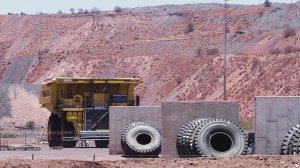Real-time data playing bigger maintenance role



OSSIE CARSTENS An optimal maintenance regime ensures timeous service intervals and component replacements that will improve the availability of equipment
BIG DEAL The decision to buy a piece of equipment should always include maintenance elements
Photo by Creamer Media
As the world gears up for the Fourth Industrial Revolution, African mines are embracing real-time information management systems to plug the gap left by the shortage of competent maintenance supervisors and mining equipment operators, Mining Equipment Manufacturers of South Africa CEO Ossie Carstens tells Mining Weekly.
“The explosive growth seen in mechanised mining in the past 30 years or so has led to the shortage of mining and engineering supervisors, as good artisans were quickly promoted to supervisory positions without the proper training.”
Machine operators were also rushed into statutory positions without receiving proper training; however, “there is no such thing as a poor artisan or operator, but rather a poor supervisor”, notes Carstens.
A supervisor needs to ensure, through proper inspections and management, that artisans perform and maintain exceptional maintenance activities. “Access to real-time information from mining equipment assists maintenance supervisors and enables mines to plan for eventualities and schedule unplanned maintenance activities in specified time slots,” says Carstens.
Inadequately trained operators can drastically reduce the life of components such as tyres, engines and brakes, and it is in this regard that real-time information management systems assist mines by recording information detailing the performance of mining equipment, and notifying mines when sensors on mining equipment are disconnected.
Carstens says machine operators are typically rewarded for output measured in tons hauled or holes drilled per shift. It is when chasing such narrowly defined output targets that operators are tempted to disconnect supervisory sensors that shut down equipment when faults are detected. However, real-time information management systems can identify the responsible operator.
These systems can even program mining equipment to shut down if deemed necessary to prevent catastrophic failures.
The maintenance cost over the useful life of a well-maintained and -used machine is typically about 1.5 times the capital cost of the machine. Excluding processing, smelting and refining activities, maintenance costs for a hard-rock mine with a vertical shaft could range between 10% and 12% of its operating costs.
Therefore, the decision to buy a piece of equipment relies heavily on the total cost of ownership and the reliability of the equipment.
“However, reliability is influenced by the expertise of a mine’s maintenance team, the availability of spare parts, the life span of the parts and components, the efficacy of the maintenance regime and the mining conditions in which the equipment is operating,” Carstens highlights.
Maintenance intervals should be designed around the mining method and maintenance regime employed, and should never be deviated from.
If the factors influencing mining equipment reliability are not properly managed, its unit cost (rands per ton or rands per hour) can severely affect the operating cost of a mine, as it not only affects the maintenance cost but also unplanned downtime, which impacts on production and, ultimately, the unit cost of a mine, Carstens warns.
Buying a piece of equipment will, subsequently, also include maintenance elements.
“This is even more pronounced in Africa, as availability of parts plays a bigger role the further the end-user is based from the original-equipment manufacturer.”
Maintenance Factors
Factors that could escalate maintenance costs on a mechanised mine include a lack of proper workshop facilities, a poor maintenance regime and purchasing policies, using inferior replacement parts, poor ventilation, low-quality diesel and lubricants, as well as poorly maintained roadways.
Improper facilities will stifle a good maintenance regime and compromise the life of components and, subsequently, result in a decrease of not only availability and reliability but also production volumes, says Carstens.
“An optimal maintenance regime ensures timeous service intervals and component replacements that will improve the availability of equipment. Life-cycle costs of components can be properly tracked and interventions planned for continuous improvement initiatives,” he notes.
However, the quality of parts bought should also be considered, as the cheapest parts are rarely the cheapest over time, especially if their service life is not well-tracked and recorded.
For example, diesel engines are not designed to work continuously under load in ambient temperatures exceeding 40 ºC. Therefore, if the environment is excessively hot and dusty, and the maintenance regime does not cater for focused filter change-outs, it can drastically shorten the life of an engine.
Low-quality diesel also influences the life of injectors and, ultimately, an engine as a whole, in addition to having an adverse impact on carbon emissions underground, as the particulate matter in the diesel engine emissions increases drastically using diesel, which has high sulphur content and other foreign particle content.
Low-quality engine oil also has a negative impact on the life of an engine, owing to carbon build-up in the intake manifold and combustion chambers, while inferior-quality or the wrong grade of hydraulic oil will lower the life of mining equipment’s hydraulic components.
To significantly reduce driveline wear and extend component life, he suggests that a grader is permanently kept in proximity to scrape the haulage roads during off-peak times.
Spraying dust suppressant on roadways is also an important maintenance aspect, as is ensuring water is not left to pool on mine site haulage ways to significantly increase tyre life.
Carstens says accidents during maintenance seldom occur, but when they do, they are typically owing to ill-discipline.
Accidents caused by a lack of maintenance are also seldom, but usually involve brakes failing, pedestrian detection systems malfunctioning and faulty lights and warning sirens.
Comments
Press Office
Announcements
What's On
Subscribe to improve your user experience...
Option 1 (equivalent of R125 a month):
Receive a weekly copy of Creamer Media's Engineering News & Mining Weekly magazine
(print copy for those in South Africa and e-magazine for those outside of South Africa)
Receive daily email newsletters
Access to full search results
Access archive of magazine back copies
Access to Projects in Progress
Access to ONE Research Report of your choice in PDF format
Option 2 (equivalent of R375 a month):
All benefits from Option 1
PLUS
Access to Creamer Media's Research Channel Africa for ALL Research Reports, in PDF format, on various industrial and mining sectors
including Electricity; Water; Energy Transition; Hydrogen; Roads, Rail and Ports; Coal; Gold; Platinum; Battery Metals; etc.
Already a subscriber?
Forgotten your password?
Receive weekly copy of Creamer Media's Engineering News & Mining Weekly magazine (print copy for those in South Africa and e-magazine for those outside of South Africa)
➕
Recieve daily email newsletters
➕
Access to full search results
➕
Access archive of magazine back copies
➕
Access to Projects in Progress
➕
Access to ONE Research Report of your choice in PDF format
RESEARCH CHANNEL AFRICA
R4500 (equivalent of R375 a month)
SUBSCRIBEAll benefits from Option 1
➕
Access to Creamer Media's Research Channel Africa for ALL Research Reports on various industrial and mining sectors, in PDF format, including on:
Electricity
➕
Water
➕
Energy Transition
➕
Hydrogen
➕
Roads, Rail and Ports
➕
Coal
➕
Gold
➕
Platinum
➕
Battery Metals
➕
etc.
Receive all benefits from Option 1 or Option 2 delivered to numerous people at your company
➕
Multiple User names and Passwords for simultaneous log-ins
➕
Intranet integration access to all in your organisation




















